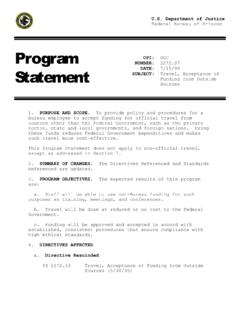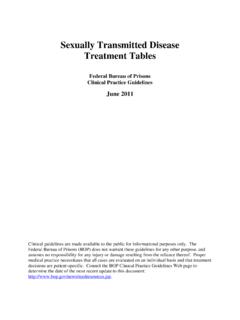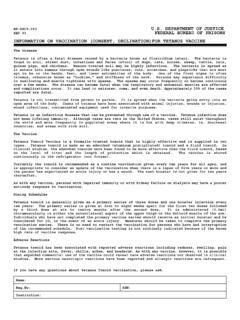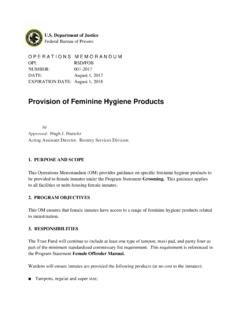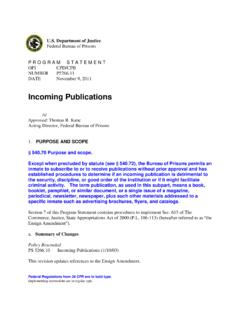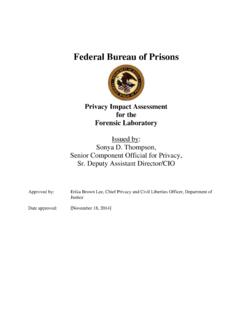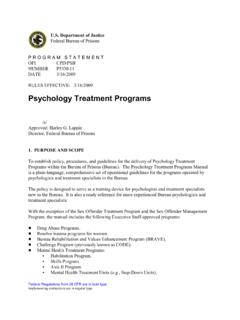Transcription of Medical Management of Malnutrition (Undernutrition)
1 Medical Management OF. Malnutrition (UNDERNUTRITION). Federal Bureau of Prisons Clinical Guidance SEPTEMBER 2014. (REFORMATTED MARCH 2018). Federal Bureau of Prisons (BOP) Clinical Guidance is made available to the public for informational purposes only. The BOP does not warrant this guidance for any other purpose, and assumes no responsibility for any injury or damage resulting from the reliance thereof. Proper Medical practice necessitates that all cases are evaluated on an individual basis and that treatment decisions are patient specific. Consult the BOP Health Management Resources Web page to determine the date of the most recent update to this document: Federal Bureau of Prisons Medical Management of Malnutrition (Undernutrition). Clinical Guidance September 2014. TABLE OF CONTENTS. 1. PURPOSE AND T ERMINOLOGY .. 1. 2. IMPORTANCE OF EARLY INTERVENTION AND MONITORING .. 1. 3. ETIOLOGIES .. 1. FIGURE 1. Etiology-Based Malnutrition Definitions .. 2. Progression of Malnutrition .
2 2. 4. Malnutrition SCREENING .. 3. acute and Long-Term Care Screening .. 3. Ambulatory Care Screening .. 3. 5. ADVANCED CLINICAL ASSESSMENT .. 3. 6. DIAGNOSIS .. 4. Serum Protein .. 4. 7. INTERVENTION .. 4. Severe 4. Nutrition Intervention .. 5. Pharmacology .. 5. Parenteral and Enteral 5. REFERENCES .. 6. APPENDIX 1: Malnutrition SCREENING T OOL (MST).. 7. APPENDIX 2: MINI NUTRITION ASSESSMENT (MNA ) .. 8. APPENDIX 3: CLINICAL CHARACTERISTICS T HAT SUPPORT A DIAGNOSIS OF Malnutrition .. 10. APPENDIX 3A: SUBCUTANEOUS FAT LOSS .. 11. APPENDIX 3B: MUSCLE L OSS .. 12. APPENDIX 3C: EDEMA .. 13. APPENDIX 4: RECOMMENDED OUTCOME MEASURES FOR SEVERE Malnutrition .. 14. i Federal Bureau of Prisons Medical Management of Malnutrition (Undernutrition). Clinical Guidance September 2014. 1. PURPOSE AND TERMINOLOGY. The Federal Bureau of Prisons (BOP) Clinical Guidance for the Medical Management of Malnutrition (Undernutrition) provides recommendations for the assessment and nutritional augmentation of inmates who are in a malnourished state.
3 Malnutrition , which can be defined as inadequate and/or unbalanced nutritional intake, may arise in cases of either undernutrition (insufficient calories) or overnutrition (too many calories). The term undernutrition applies to individuals who lack the calories, protein, or other nutrients needed for tissue maintenance and repair. Identification and treatment of adult undernutrition is a major concern in acute , chronic, and transition care settings. For the purposes of these guidelines, therefore, the term Malnutrition will be used to refer solely to undernutrition. 2. IMPORTANCE OF EARLY INTERVENTION AND MONITORING. Malnutrition in adults is a major health problem that continues to go unrecognized and, therefore, untreated. It is both a cause and a consequence of ill health across many patient groups and healthcare settings. Current estimates of the prevalence of adult Malnutrition range from 15% to 60%, depending on the patient population and the criteria used to identify its occurrence.
4 It is estimated that at least one-third of the patients admitted to the hospital in developed countries are malnourished; if their Malnutrition is left untreated, approximately two-thirds of these patients will experience a further decline in their nutritional status during inpatient stay. Moreover, among patients who are not malnourished upon admission, approximately one-third may become malnourished while in the hospital. A variety of factors may contribute to a decline in nutritional status such as mental/cognitive status, illness-induced poor appetite, gastrointestinal symptoms, reduced ability to chew or swallow, or nil per os (NPO) status for diagnostic and therapeutic procedures. According to the American Society for Parenteral and Enteral Nutrition (ASPEN), although data vary across studies, available evidence shows that early nutrition intervention can reduce complication rates, length of hospital stay, readmission rates, mortality, and cost of care. Evidence-based recommendations support the screening, assessment, intervention, and monitoring of Malnutrition .
5 See Sections 3 7 of these guidelines for information on Etiologies, Screening, Advanced Clinical Assessment, Diagnosis, and Intervention. 3. ETIOLOGIES. A recommended etiology-based approach to the diagnosis of adult Malnutrition in clinical settings was endorsed in 2009 by ASPEN and the European Society for Clinical Nutrition and Metabolism (ESPEN). This approach (see Figure 1 below) focuses on three etiologies: starvation- related Malnutrition , chronic disease-related Malnutrition , and acute disease or injury-related Malnutrition . It also takes into consideration the role of inflammation as an important factor in the increased risk for Malnutrition . 1. Federal Bureau of Prisons Medical Management of Malnutrition (Undernutrition). Clinical Guidance September 2014. FIGURE 1. ETIOLOGY-BASED Malnutrition DEFINITIONS. NUTRITION RISK IDENTIFIED: Compromised intake or loss of body mass INFLAMMATION PRESENT? NO YES YES. Mild to Moderate Marked Inflammatory Inflammation Response STARVATION-RELATED CHRONIC DISEASE-RELATED acute DISEASE OR INJURY- M ALNUTRITION M ALNUTRITION* RELATED M ALNUTRITION**.
6 (pure chronic starvation, ( , organ failure, pancreatic ( , major infection, burns, anorexia nervosa) cancer, rheumatoid arthritis, trauma, closed head injury). sarcopenic obesity). Adapted from: White JV, Guenter P, Jensen G, Malone A, Schofield M. Consensus statement of the Academy of Nutrition and Dietetics/ASPEN: characteristics recommended for the identification and documentation of adult Malnutrition (undernutrition). J Acad Nutr Diet. 2012;112(5):732. Available at: * Other chronic diseases or conditions that can result in Malnutrition : Cardiovascular disease, cancer, celiac disease, chronic pancreatitis, chronic obstructive pulmonary disease, congestive heart failure, cystic fibrosis, dementia, diabetes mellitus, IBD, gastrointestinal and liver disease, hematologic malignancies, HIV and AIDS, metabolic syndrome , neurological disease, neuromuscular disease, obesity, old age, organ failure/transplant, poor dentition/oral condition, pressure wounds, renal disease, respiratory disease, solid tumors.
7 ** Other acute diseases/injuries that can result in Malnutrition : Adult respiratory distress syndrome , closed head injury, critical illness, major abdominal surgery, major infection/sepsis, multi-trauma, orthopedic injury, systemic inflammatory response syndrome , severe burns, severe acute pancreatitis. Patients with acute or chronic illness present a more complex challenge in determining the presence, etiology, and extent of Malnutrition and in determining the appropriate nutrition interventions. PROGRESSION OF Malnutrition . According to the 2012 Consensus Statement published by ASPEN and the Academy of Nutrition and Dietetics (see References page), Malnutrition in adults typically occurs along a continuum of inadequate intake and/or increased requirements, impaired absorption, altered transport, and altered nutrient utilization. Weight loss can, and frequently does, occur at any one or more points along this continuum. Individuals may also present with inflammatory, hypermetabolic, and/or hypercatabolic conditions.
8 2. Federal Bureau of Prisons Medical Management of Malnutrition (Undernutrition). Clinical Guidance September 2014. The Consensus Statement also noted that inflammation is increasingly identified as an important underlying factor that increases risk for Malnutrition , [one] that may contribute to suboptimal responses to nutrition intervention and increased risk for mortality. As such, individuals may exhibit a wide range of characteristics, starting with non-severe (mild to moderate). Malnutrition that if left unrecognized and unaddressed, is likely to progress to a severely malnourished state. 4. M ALNUTRITION SCREENING. acute AND LONG-TERM CARE SCREENING. Comprehensive nutrition screening for all hospitalized patients should occur in the acute and long-term care settings within 24 hours of admission, to identify individuals who are at risk for Malnutrition and allow for nutrition care planning. Malnutrition screening should be performed as part of Medical Referral Center (MRC) nursing admission assessments for inpatient, mental health, and long-term care units, using the Malnutrition Screening Tool (MST) (see Appendix 1).
9 Repeat Malnutrition screening for patients initially screened as low-risk should be performed according to the policies of the individual facility or as determined by the patient care team. AMBULATORY CARE SCREENING. If Malnutrition is suspected in patients seen in ambulatory care settings, screening can be performed by nursing staff, nursing assistants, administrative staff, physicians, or dietitians. In the ambulatory care setting, screening should be performed in accordance with the Mini Nutrition Assessment (MNA) (see Appendix 2). If Malnutrition is identified in ambulatory care patients, the physician, ideally in concert with a BOP registered dietitian, should provide advanced clinical assessment (see Section 5 below). Dentists who suspect Malnutrition should refer patients to the Medical staff or a BOP registered dietitian for Malnutrition assessment. 5. ADVANCED CLINICAL ASSESSMENT. If a patient is considered to be at-risk for Malnutrition , the Medical provider and an MRC.
10 Dietitian should work together to determine the potential etiology conducting a careful review of the patient's chief complaint, as well as the patient's systems; Medical , nutrition, and psychosocial histories; mental health status; physical exam; laboratory markers of inflammation;. anthropometric parameters; food intake; oral/dentition conditions, and functional status. 3. Federal Bureau of Prisons Medical Management of Malnutrition (Undernutrition). Clinical Guidance September 2014. 6. DIAGNOSIS. Since no single factor is conclusive in determining the presence of adult Malnutrition , diagnosis should be based on identifying at least two of the following characteristics: See Appendix 3 for more detail. (1) Insufficient energy intake (2) Weight loss (3) Loss of subcutaneous fat (4) Loss of muscle mass (5) Localized or generalized fluid accumulation, which may sometimes mask weight loss (6) Diminished functional status, as measured by hand grip strength Assessment of these characteristics aids in distinguishing between non-severe (mild to moderate).
